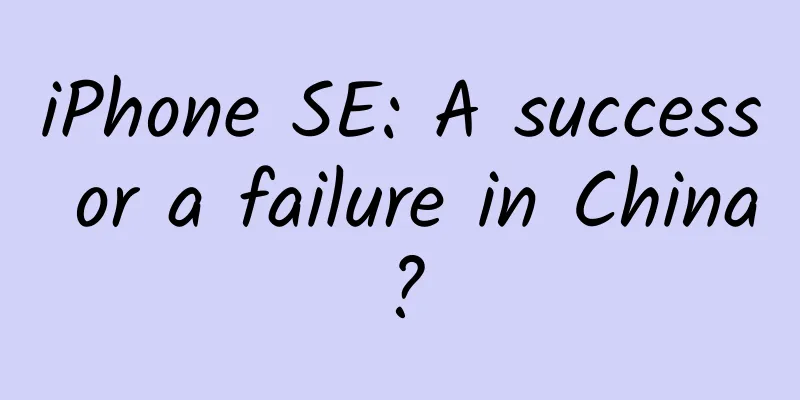iPhone SE: A success or a failure in China?

|
New data shows that Apple's iPhone market share in China has declined, so how is its latest low-cost product, the iPhone SE, performing? Fool.com, a US financial analysis website, provides the following analysis. Apple launched the cheaper iPhone SE in March this year, mainly targeting the more price-sensitive market, especially the Chinese market, but according to market research firm Counterpoint Research, Apple's share in this important market has declined. Does this mean that the iPhone SE is not as good as management expected? Counterpoint Research said that only 10.8% of the mobile phones sold in the Chinese market in May were iPhones. This figure is a slight decline from Apple's 12% in the same period last year. Currently, Apple's share of the Chinese market can only rank fifth. More importantly, the companies ahead of Apple are all Chinese local brands that mainly produce low-priced products. Apple launched the iPhone SE in March, which starts at $399, $250 cheaper than its latest flagship model, but investors should note that Apple's decline in market share this year does not mean that the iPhone SE is not in great demand in the Chinese market. The fact is, despite the iPhone's decline in China market share in May, there is reason to believe that the iPhone SE is selling well in China, just as investors expect. For most of Apple's fiscal third quarter, iPhone SE shipments were tight, and consumers who wanted to buy it had to wait for weeks to see Apple deliveries even in late June. The tight shipments of iPhone SE in the third quarter indicate two things: First, it suggests that demand for iPhone SE in the third quarter exceeded management's expectations. Second, interpreting Counterpoint's data in another way, given the tight supply of Apple's latest iPhone in the third quarter, the loss of market share only means a small year-on-year decline. Whether or not the iPhone SE is successful in the Chinese market, Apple needs to come up with more ideas than just improving the performance of the machine in the appearance of three years ago to revive the once-prosperous Chinese market. Apple's revenue in Greater China (including mainland China, Taiwan, China, and Hong Kong) is under great pressure, and its second-quarter data shows that the company's revenue in the region has fallen 26% year-on-year. It is worth mentioning that Apple's revenue decline in Greater China does not fully reflect the situation facing Apple products in this market. Apple CEO Tim Cook gave a more detailed analysis of the revenue data for Greater China in the second quarter conference call, which reflected a more optimistic mood. Cook said: "We are very focused on Greater China, specifically the mainland China market, where revenue is down 11% year-on-year. Based on exchange rate factors, our revenue in mainland China is down 7%, and the actual sales data is only down 5%. Remember, our revenue in the same period last year was up 81% year-on-year." Cook's last statement deserves further emphasis. Apple's revenue in mainland China increased by 81% year-on-year in the same period last year, and this comparison is to illustrate how well the company performs in the Chinese market. Apple's second quarter revenue in mainland China still showed significant growth compared with the same period two years ago. However, Apple's current lack of growth in China shows that it is not as easy to achieve growth in this market as before. Cook even said in the second quarter conference call that Apple "may have lost the tailwind that has been driving it forward in China." Overall, the decline in iPhone market share in China and the decline in Apple's revenue in Greater China in the second quarter may make Apple's situation in the Chinese market look more severe. This is indeed a concern worth paying attention to. If Apple's sales continue to decline in its second-largest market for a longer period of time, the company's price-to-earnings ratio of 11 times may look high. As a winner of Toutiao's Qingyun Plan and Baijiahao's Bai+ Plan, the 2019 Baidu Digital Author of the Year, the Baijiahao's Most Popular Author in the Technology Field, the 2019 Sogou Technology and Culture Author, and the 2021 Baijiahao Quarterly Influential Creator, he has won many awards, including the 2013 Sohu Best Industry Media Person, the 2015 China New Media Entrepreneurship Competition Beijing Third Place, the 2015 Guangmang Experience Award, the 2015 China New Media Entrepreneurship Competition Finals Third Place, and the 2018 Baidu Dynamic Annual Powerful Celebrity. |
Recommend
Gas explosion accidents happen frequently! This guide can help you prevent them before they happen!
At about 11:00 on June 26, an explosion occurred ...
Operational methodology for sinking markets
Some people say that the sinking market is really...
Long-distance travel, playing mahjong and sitting for a long time may cause "fatal" blood clots! This detail is crucial
During the Spring Festival holiday, many people r...
Which one will die first under marketing, QQ Space or Moments?
Since Redmi used QQ Space as a sales platform, mo...
2020 Beauty Industry Brand Marketing Insights Report
This article shares with you the marketing trends...
Wild boars are spotted in many places. What should you do if you encounter one?
recent, Wild boars frequently appear in many plac...
Taking advantage of the Nokia 6 launch boom, let’s talk about brand licensing
After almost missing out on the entire mobile Int...
How much does it cost to develop a learning app in Liuzhou?
Liuzhou learned about the types of WeChat applet ...
Promotion analysis of the hottest marketing campaign!
Behind the popularity of grass-roots marketing is...
How do iQiyi, Youku and Tencent Video monetize advertising?
Most products in the PC era have a clear product ...
Five operational frameworks for private domain traffic!
At this stage, for e-commerce bosses, acquiring c...
Go to bed late and get up late, but get enough sleep for 8 hours! Does it count as staying up late?
It's time for the holidays again, and our ear...
How to make a good online event promotion plan?
In marketing psychology, herd mentality, the ment...
I got on a Spring Festival travel train that distorted time and space?!
1 Strange things happened on the train A while ag...
Why iOS may become the next generation of enterprise operating system?
[[150553]] Throughout my life, Windows and Mac op...









